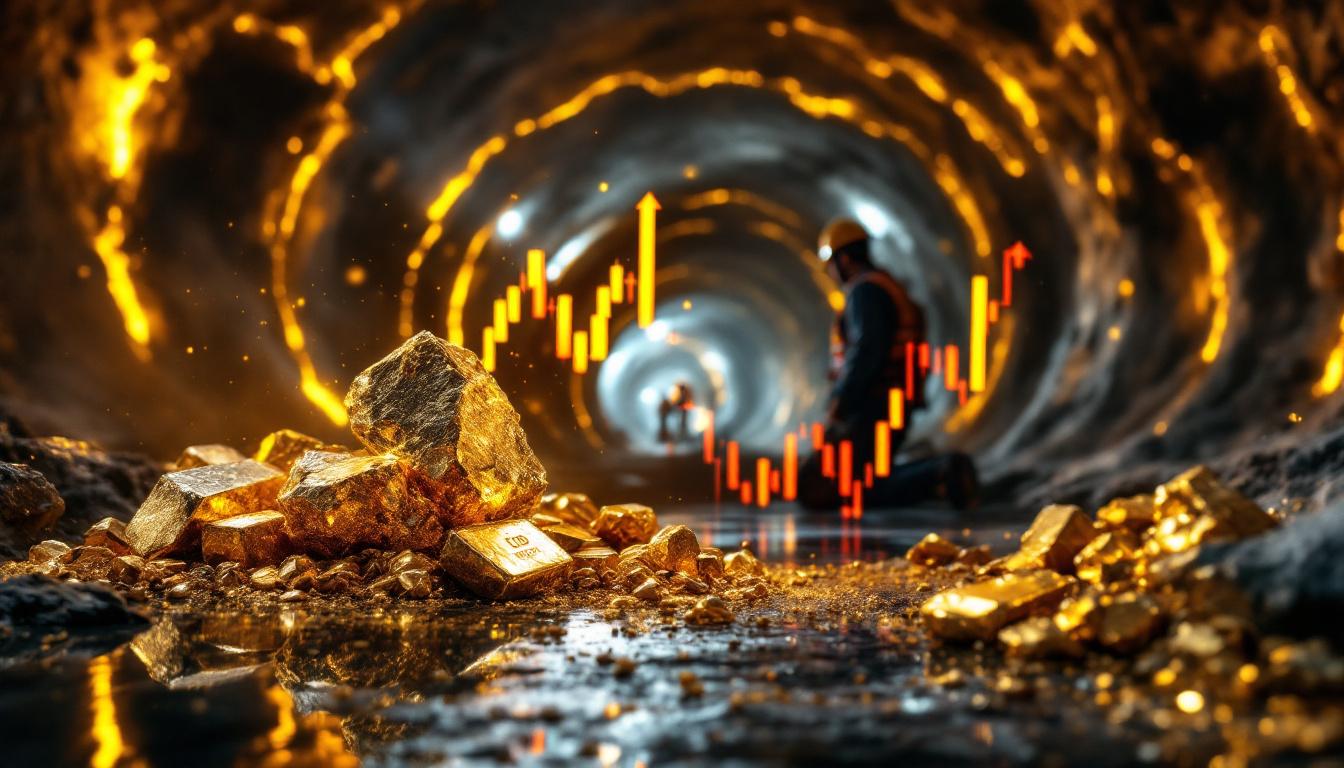What's Driving the Historic Precious Metals Rally?
The precious metals market is experiencing a historic transformation, with gold achieving its most significant breakout in 50 years and silver following closely behind. This unprecedented movement is directly connected to mounting global debt concerns, central bank policies, and a fundamental shift in how investors view traditional safe-haven assets.
The Global Debt Time Bomb
The world is facing an unprecedented debt crisis that threatens to reshape financial markets and drive investors toward precious metals. Global debt has reached unsustainable heights, creating a precarious situation for governments worldwide.
How Did We Get Here?
-
Abandoning the Gold Standard: Since 1971, when the U.S. dollar was decoupled from gold, global debt has exploded from $398 billion to over $37 trillion according to U.S. Treasury Fiscal Data
-
Accelerating Debt Accumulation: The rate of debt accumulation continues to increase yearly, with approximately $2 trillion added in the past year alone
-
Short-Term Financing Strategy: Governments have increasingly relied on short to medium-term debt instruments rather than long-term bonds
-
Rising Interest Rates: After decades of declining rates, interest rates have been climbing since 2020, creating unsustainable debt servicing costs
Key Insight: The combination of massive debt accumulation and rising interest rates has created a perfect storm that threatens the stability of global bond markets.
Why Interest Payments Are Crushing Government Budgets
Interest payments on national debt have become one of the largest government expenditures, threatening to overtake essential services.
The Alarming Numbers
| Fiscal Year | U.S. Interest Payments | Ranking Among Government Expenditures |
|---|---|---|
| 2025 | $665 billion | 3rd largest category |
| 2026 | $952 billion (projected) | Will exceed Medicare |
| 2031 | 15.6% of total spending | Will exceed previous historical high |
| 2035 | $1.8 trillion (projected) | Could become largest expenditure |
-
Crowding Out Essential Services: Interest payments now exceed defense spending and are approaching Medicare costs
-
Percentage of Revenue: By the end of 2025, interest payments will consume 18.4% of federal revenues
-
Unsustainable Trajectory: The Congressional Budget Office projects interest costs will reach 4.1% of GDP by 2035, further exacerbating US economy & debt concerns
How Global Bond Markets Are Unraveling
The debt crisis isn't limited to the United States—it's a global phenomenon with Japan at the epicenter of the current instability.
The Japanese Canary in the Coal Mine
-
Bank of Japan's Reversal: After decades of near-zero interest rates, Japan is now facing rising rates and unwinding carry trades
-
Double Whammy Effect: Rising Japanese bond interest rates have both stopped people from buying their bonds and increased servicing costs for existing debt
-
Contagion Risk: As Japan attempts to sell bonds into the global market, it reduces available capital for other bond markets, including U.S., Chinese, and European
Expert Insight: This threatens to trigger a global debt collapse as countries compete for a shrinking pool of bond market investors.
Why Are Gold and Silver Prices Surging?
Gold's Historic 50-Year Breakout
Gold has achieved something remarkable—a technical breakout that hasn't been seen in half a century, with prices doubling in approximately 18 months between 2024-2025. Recent gold price analysis shows this trend continuing.
Technical Analysis Reveals Bullish Indicators
-
RSI Levels: Despite the significant price increase, the Relative Strength Indicator (RSI) at 71.25 suggests the market isn't overheated
-
Fibonacci Patterns: Gold has broken through the highest Fibonacci level, indicating a major technical breakout
-
Compressed Timeframe: The current price movement has compressed what previously took 3 years (2008-2011) into just 16 months
What Makes This Breakout Different?
-
Bond Market Alternative: Unlike previous rallies, investors are moving to gold because traditional safe-haven bonds are already in trouble
-
Central Bank Accumulation: According to Bloomberg's live charts, "More central banks than ever plan to build up their gold hordes," reflecting institutional confidence in gold's stability
-
Basel III and IV Requirements: Gold has been classified as a High-Quality Liquid Asset (HQLA), encouraging institutional buying and providing regulatory incentives for banks to hold physical gold
Silver's Emerging Breakout Pattern
Silver typically follows gold in market cycles, and technical indicators suggest it's poised for a significant move upward, with the silver market squeeze potentially amplifying these effects.
The Cup and Handle Formation
-
50-Year Pattern: Silver has formed a classic "cup and handle" pattern over the past 50 years—one of the most reliable bullish indicators in technical analysis
-
Breaking Seasonal Patterns: Silver prices are rising during traditionally weak summer months, indicating unusual strength
-
RSI Room to Run: With an RSI of 62.91, silver has significant room to run before reaching overbought territory
The Path to New Highs
-
Key Resistance Levels: Once silver passes $37, there is little historical resistance until $50—its all-time high from 1980 and 2011
-
Inflation-Adjusted Potential: When adjusted for inflation using the U.S. Bureau of Labor Statistics CPI Calculator, silver's 1980 high would equal approximately $250 today
-
Industrial Demand: Unlike gold, silver faces additional upward pressure from industrial shortages, particularly in solar panel and semiconductor manufacturing
How Paper Markets Differ from Physical Demand
Understanding the disconnect between paper trading and physical delivery is crucial to interpreting current gold and silver market trends.
The COMEX Casino
-
Paper vs. Physical: On the COMEX, less than 0.1% of gold and silver contracts result in physical delivery, according to 2024 COMEX data
-
Futures Market Dynamics: Most trading occurs in future months (August for gold, September for silver) rather than current delivery months
-
Manipulation Potential: As Rob Ke from Freedom Report notes, "COMEX is a casino—99.999% paper trading allows price manipulation" through leveraged positions that rarely convert to physical metal
Physical Delivery Trends
-
Consistent High Demand: Gold deliveries have been consistently high across all months of 2024, breaking the typical pattern of alternating high and low delivery months
-
Institutional Demand: Despite gold's price doubling, physical deliveries continue to increase, with approximately 29,000 gold contracts delivered in June 2025 alone
-
Silver Lagging But Building: While silver physical deliveries haven't yet matched gold's breakout pattern, they're showing signs of increasing, particularly from industrial users securing supply chains
What Are the Investment Implications?
Capital Rotation into Precious Metals
-
Outperforming Other Assets: According to Trading Economics data, gold has outperformed all other major assets in 2025, including Bitcoin and emerging markets
-
Billionaire Perspective: Paul Tudor Jones, billionaire investor, stated on CNBC, "I'm long gold, long Bitcoin, long commodities… own zero fixed income. All roads lead to inflation."
-
Inflation Hedge: As governments attempt to inflate away debt, precious metals typically serve as protection against currency devaluation. As Jones noted, "Inflating away debt is every civilization's historical playbook"
Strategic Positioning for Investors
-
Portfolio Allocation: Consider a basket of inflation hedges including gold, Bitcoin, commodities, and select technology stocks
-
Physical vs. Digital Ownership: Options range from physical possession to digital ownership platforms like Kinesis that offer yields and trading flexibility
-
Trading Strategy: Using limit orders rather than market orders can protect against price volatility when entering precious metals positions, especially during periods of high volatility
Market Insight: The rotation from traditional safe-haven assets like bonds into gold and silver represents a fundamental shift in global capital flows that could persist for years.
What's Next for Gold and Silver Markets?
Short-Term Outlook
-
Summer Trading Patterns: Precious metals markets typically experience reduced volume during summer months before strengthening in August, according to historical COMEX data
-
Technical Consolidation: After rapid price increases, both metals are likely to experience periods of consolidation before continuing their upward trends
-
Delivery Data Monitoring: Watching physical delivery trends on COMEX can provide early signals of continued institutional demand, particularly unusual consistency in monthly delivery figures
Long-Term Projection
-
50-Year Bull Market: Technical and fundamental factors suggest the beginning of a multi-decade bull market in precious metals, with the latest gold price forecast supporting this view
-
Silver's Catch-Up Phase: As Rob Ke notes, "Silver's catch-up phase typically delivers larger percentage gains than gold" once its breakout begins
-
Bond Market Collapse Catalyst: Continued deterioration in global bond markets could accelerate the move into precious metals as traditional fixed-income investments lose their appeal, affecting the gold bonds dynamics in economic cycles
How Can Investors Participate in the Precious Metals Market?
Physical Ownership Options
-
Coins and Bars: Traditional physical ownership provides direct possession but requires secure storage
-
Safety Deposit Alternatives: Consider alternatives to bank safety deposit boxes, which may have limitations during financial crises
-
Allocated Storage: Professional storage solutions that specifically allocate metals to individual owners with audit trails and redemption guarantees
Digital and Exchange-Traded Options
-
Digital Ownership Platforms: Services like Kinesis offer digital ownership with yield potential and trading flexibility, backed by allocated physical metal
-
ETFs and Mining Stocks: Provide exposure to metals prices without physical handling requirements, though with counterparty risks
-
Trading Strategies: Using limit orders rather than market orders can help secure better entry and exit prices in volatile markets
Risk Management Considerations
-
Diversification: Precious metals should be part of a broader inflation-protection strategy
-
Entry Timing: Consider dollar-cost averaging rather than lump-sum investments given current elevated prices
-
Exit Strategy: Develop clear parameters for when to take profits or rebalance holdings based on technical indicators and market conditions
FAQs About Gold and Silver Markets
How does inflation affect gold and silver prices?
Historically, precious metals have served as inflation hedges, maintaining purchasing power when fiat currencies lose value. During periods of high inflation, both metals typically appreciate as investors seek assets that can't be devalued through currency printing.
Why does silver typically follow gold in bull markets?
Silver follows gold because gold is the primary monetary metal that initially attracts investment during economic uncertainty. Once gold prices rise significantly, silver becomes more attractive due to its relative affordability and industrial applications, often resulting in larger percentage gains.
What's the significance of the COMEX market for precious metals prices?
The COMEX futures market establishes benchmark prices for gold and silver through paper trading, despite representing very little physical metal changing hands. This creates a disconnect between paper prices and physical availability, potentially leading to price volatility when physical demand increases significantly.
How do central bank purchases affect the gold market?
Central banks have become net buyers of gold over the past decade, adding significant demand to the market. When central banks increase gold reserves, they typically hold these positions long-term, effectively removing supply from the market and supporting higher prices.
What's the relationship between bond markets and precious metals?
Traditionally, bonds and precious metals have had an inverse relationship, with investors choosing between yield-bearing bonds or non-yielding metals. However, when bond markets face instability or negative real yields (after inflation), investors often shift capital from bonds to precious metals for wealth preservation.
Further Exploration:
Readers interested in learning more about gold and silver market trends can also explore related educational content, such as The Freedom Report's YouTube analysis on gold markets, which offers another perspective on precious metals and global debt dynamics.
Disclaimer: This article contains market analysis and investment information that should not be construed as financial advice. Precious metals markets involve risk, and past performance is not indicative of future results. Consider consulting with a financial professional before making investment decisions.
Want to Spot the Next Major Mineral Discovery?
Discovery Alert instantly notifies investors of significant ASX mineral discoveries through its proprietary Discovery IQ model, helping you capitalise on investment opportunities ahead of the market. Understand how historic discoveries can generate substantial returns by exploring Discovery Alert's dedicated discoveries page.




